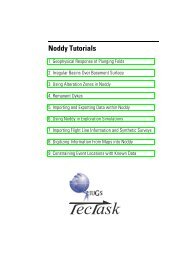Revised Eburnean geodynamic evolution of the ... - Tectonique.net
Revised Eburnean geodynamic evolution of the ... - Tectonique.net
Revised Eburnean geodynamic evolution of the ... - Tectonique.net
Create successful ePaper yourself
Turn your PDF publications into a flip-book with our unique Google optimized e-Paper software.
S. Perrouty et al. / Precambrian Research 204– 205 (2012) 12– 39 13<br />
Fig. 1. (A) The West African Craton (modified after Milési et al., 2004, BRGM SIGAfrique) is composed <strong>of</strong> an Archean nucleus in <strong>the</strong> southwest bounded by series <strong>of</strong><br />
paleoproterozoic greenstone belts and voluminous granitoids in <strong>the</strong> northwest to <strong>the</strong> east. (B) Simplified geology map <strong>of</strong> <strong>the</strong> Ashanti Belt (modified after Agyei Duodu et al.,<br />
2009) showing <strong>the</strong> locations <strong>of</strong> Figs. 6, 14 and 16.<br />
that affected both <strong>the</strong> Birimian Supergroup and overlying Tarkwaian<br />
sediments. This second phase <strong>of</strong> <strong>the</strong> <strong>Eburnean</strong> orogeny is<br />
relatively well known in <strong>the</strong> study area and is described at <strong>the</strong><br />
mine scale (Blenkinsop et al., 1994, in Obuasi; Allibone et al., 2002a,<br />
in Obuasi and, Allibone et al., 2002b, in Bogoso; Kutu, 2003, in<br />
Konongo; Tunks et al., 2004, in Damang) and at a regional scale<br />
(Eisenlohr and Hirdes, 1992; Milési et al., 1992; Ledru et al., 1994;<br />
Barritt and Kuma, 1998; Feybesse et al., 2006).<br />
<strong>Eburnean</strong> I events have been described along <strong>the</strong> West African<br />
Craton and called Eoeburnean in nor<strong>the</strong>rn Ghana (De Kock et al.,<br />
2011) or Tangaean in Burkina Faso (Tshibubudze et al., 2009; Hein,<br />
2010), but are relatively poorly resolved in southwestern Ghana.<br />
This study presents an integrated interpretation based on new field<br />
data, geophysical surveys and previous structural studies and maps<br />
(Loh et al., 1999; Agyei Duodu et al., 2009) that provides a new<br />
structural context to <strong>the</strong> Eoeburnean phase and clarifies <strong>the</strong> subsequent<br />
tectonic <strong>evolution</strong> <strong>of</strong> <strong>the</strong> Ashanti greenstone belt.<br />
2. Geological setting<br />
The sou<strong>the</strong>rn part <strong>of</strong> <strong>the</strong> West African Craton, known as <strong>the</strong> Leo-<br />
Man craton, is composed <strong>of</strong> an Archean nucleus that is tectonically<br />
juxtaposed against Paleoproterozoic granitoid-greenstone assemblages<br />
to <strong>the</strong> north and east (Fig. 1). In southwest Ghana, four<br />
NE-SW greenstone belts occur, known as <strong>the</strong> Bui, Sefwi, Ashanti<br />
and Kibi-Winneba belts from west to east, respectively. These belts<br />
are separated by three sedimentary basins namely <strong>the</strong> Sunyani, <strong>the</strong><br />
Kumasi and <strong>the</strong> Akyem Basins (or Cape Coast Basin, Agyei Duodu<br />
et al., 2009). These greenstone belts and dividing sedimentary<br />
basins were formed and deformed during <strong>the</strong> <strong>Eburnean</strong> orogeny<br />
(Bonhomme, 1962).<br />
2.1. <strong>Eburnean</strong> orogeny<br />
Feybesse et al. (2006) proposed an early <strong>Eburnean</strong> phase<br />
between 2135 Ma and 2100 Ma corresponding to magmatic accretion<br />
and plutonism that terminated with development <strong>of</strong> <strong>the</strong><br />
Kumasi Basin. The synchronous <strong>Eburnean</strong> orogeny (2130–1980 Ma)<br />
corresponds to thrust tectonism dominated by sinistral transcurrent<br />
deformation in <strong>the</strong> Ashanti Belt. Allibone et al. (2002a) suggests<br />
an alternative two phase <strong>Eburnean</strong> <strong>evolution</strong>, divided into <strong>the</strong><br />
<strong>Eburnean</strong> I (2200–2150 Ma) and <strong>Eburnean</strong> II (2116–2088 Ma), that<br />
are separated by deposition <strong>of</strong> <strong>the</strong> Birimian and Tarkwaian units. In<br />
nor<strong>the</strong>rn Ghana De Kock et al. (2011) called <strong>the</strong>se two phases Eoeburnean<br />
and <strong>Eburnean</strong>, respectively. This nomenclature is referred<br />
to in <strong>the</strong> text, based on <strong>the</strong> correlation with published zircon<br />
geochronology (Fig. 2A).




